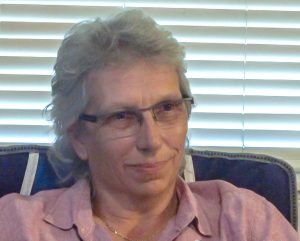part 1 of 4
by Mary Jo Tesitor
HUERFANO — In an industrial-looking blue and white building on west Ninth Street, it is 9 am. Cars and vans pull into the parking lot to drop off chatty, smiling adults from private homes and public housing around the county, some in wheelchairs, some with canes or walkers, some helping others with assistive devices.
Other groups are loading into vans, ready for a morning of cleaning at an office building in Pueblo. Supervisors inside prepare for a day of lessons in life skills, arts and crafts, and adult daycare. Participants, known as “consumers,” greet each other with hugs and familiar jokes.
This is the home of Walsenburg Day Services and the Southern Colorado Developmental Disability Services (SCDDS), where local adults receive supervision and training due them through Social Security Disability as administered by the local Community Centered Board, Southern Colorado Developmental Services.
ADA Recent History
On July 26, 2012, President Barack Obama marked by proclamation the 22nd anniversary of the Americans with Disabilities Act (ADA) which prohibits discrimination based on disability. Most people don’t realize that the civil rights act of 1964 made “discrimination based on race, religion, gender, national origin, and other characteristics” illegal, but failed to afford similar protection to those with “a physical or mental impairment that substantially limits a major life activity.”
It was not until 1990 that President George H. W. Bush signed into law the ADA, creating civil rights protections for Americans with physical, mental or cognitive disabilities. Eighteen years later, President George W. Bush signed into law the ADA Amendments Act of 2008, providing protections for workers whose disability might affect a broad range of “major life activities.”
On one hand, this was a far cry from the lack of protection suffered by our forefathers whose debilitating injuries in coal mines and factories spurred the formation of the United Mine Workers and AFL/CIO and the many benevolent religious, ethnic and philosophical brotherhoods so prevalent in the early 20th century. On the other hand, the law mandated accommodation retrofits of everyone, even small businesses and religious institutions, which sometimes created an unintended animosity between religious organizations and the very “least brothers” whom they served.
As with any civil rights legislation, there is a wide gulf between passage and actual implementation. In the end, we can all benefit from the accessibility required by the ADA. Be it by injury, illness or old age, every one of us is “disabled” at some point in our lives.
In an effort to streamline administration, the U.S. Department of Health and Human Services (HHS) in April of this year initiated the Administration for Community Living (ACL) to “enhance and strengthen HHS efforts to support seniors and people with disabilities.“ The ACL combines the Administration on Aging and the Administration on Developmental Disabilities to focus on “the unique needs of individual groups such as children with developmental disabilities, adults with physical disabilities, or seniors, including seniors with Alzheimers” and to “help seniors and people with disabilities live in their homes and fully participate in their communities.” (http://www.hhs.gov/acl)
The changes brought on by the ACL have recently impacted the local Community Centered Board, throwing another monkey wrench of complexity into a system whose navigation now requires a trained guide. Transition will take some time to “shake out”.
Preview of this series of articles
Over the next few weeks, we will look at the history of disability in Colorado and recall stories of relatives and local kids who were hidden away because they were “different”. We will visit the story of Little Joe, the man with an intellectual disability who was wrongly executed in Colorado in 1936 and not pardoned until 92 years later. We will examine the past, present and future of SCDDS and Walsenburg Day Services, as well as visit with members of this “invisible community within our community” who are our brothers, sisters, children and friends.
We will listen to the stories of their childhood experiences of abuse suffered because of their disabilities or that sometimes caused their disabilities. We will talk to them about their hopes and dreams and about where they see themselves in the future. Finally, we will look to the future of citizens with disabilities in our community with the knowledge that, as Pogo said in the comics, “we have met the enemy, and he is us.” When we least expect it, we or someone we love will become members of this fraternity of disability.




